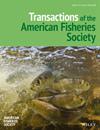光污染对蓝鳃鱼觅食行为的影响
IF 1.4
3区 农林科学
Q2 FISHERIES
引用次数: 0
摘要
摘要:夜间人造光(ALAN)是最普遍和最迅速扩大的人为污染源之一。水生生态系统可能特别容易受到ALAN的影响,因为它们不成比例地暴露于人为压力之下。然而,关于水生物种对ALAN的反应机制的研究仍然很少。本研究考察了ALAN对大蓝鳃鱼夜间取食效率的影响程度。我们使用一系列室外环境水箱,将幼蓝鳃鱼分配到五种夜间照明处理(控制黑暗、1勒克斯、4勒克斯、12勒克斯和间歇性12勒克斯)。我们进行了为期六周的每周夜间喂食试验,以评估四个猎物捕获变量,包括捕获效率(猎物攻击的有效性)、捕获率(捕获猎物的数量)、攻击率(猎物攻击的频率)和延迟(第一次猎物攻击之前的时间)。根据我们之前在野外测量的夜间城市光强度选择的稳定照明处理对任何猎物捕获变量都没有明显的影响。然而,闪烁的高强度灯光(旨在模仿繁忙高速公路上过往汽车前灯的效果)对捕获率和攻击率有显著的负面影响,从而抑制了鱼类攻击和捕获猎物的能力。我们的研究结果表明,光污染(尤其是闪烁或间歇性的光)可能会干扰这种生态和经济上重要的运动鱼的觅食行为。本文章由计算机程序翻译,如有差异,请以英文原文为准。
Effects of light pollution on Bluegill foraging behavior
Abstract Artificial light at night (ALAN) is one of the most pervasive and rapidly expanding sources of anthropogenic pollution. Aquatic ecosystems may be especially vulnerable to the effects of ALAN due to their disproportionate exposure to anthropogenic pressures. However, research on mechanisms of response to ALAN by aquatic species remains sparse. Our research investigated the extent to which ALAN influences the nocturnal feeding efficiency of Bluegill Lepomis macrochirus . Using an array of outdoor mesocosm tanks, we assigned juvenile Bluegill to five nighttime lighting treatments (control dark, 1 lux, 4 lux, 12 lux, and intermittent 12 lux). We conducted weekly nighttime feeding trials for six weeks to assess four prey capture variables, including capture efficiency (the effectiveness of prey strikes), capture rate (the number of prey items captured), strike rate (the frequency of prey strikes), and latency (time elapsed before the first prey strike). The steady lighting treatments, which were selected based on nighttime urban light intensities we previously measured in the field, had no apparent effect on any of the prey capture variables. However, flashing high intensity lights (intended to mimic the effect of passing car headlights on a busy highway) had a significant negative effect on capture rate and strike rate, thereby inhibiting the ability of fish to strike at and capture prey. Our results demonstrate the potential for light pollution (especially flashing or intermittent lights) to interfere with the foraging behavior of this ecologically and economically important sportfish.
求助全文
通过发布文献求助,成功后即可免费获取论文全文。
去求助
来源期刊
CiteScore
2.90
自引率
7.10%
发文量
48
审稿时长
8-16 weeks
期刊介绍:
Transactions of the American Fisheries Society is a highly regarded international journal of fisheries science that has been published continuously since 1872. It features results of basic and applied research in genetics, physiology, biology, ecology, population dynamics, economics, health, culture, and other topics germane to marine and freshwater finfish and shellfish and their respective fisheries and environments.

 求助内容:
求助内容: 应助结果提醒方式:
应助结果提醒方式:


